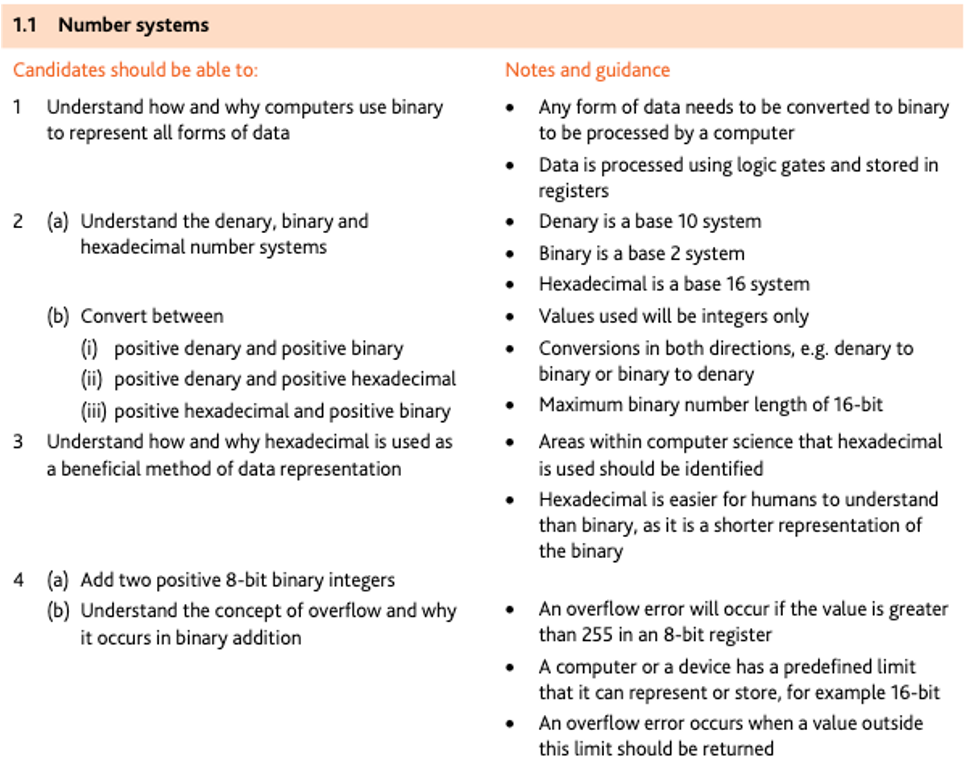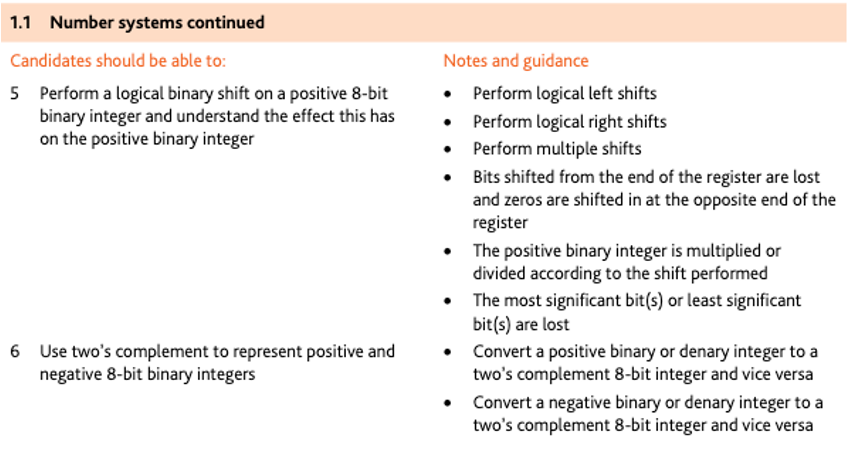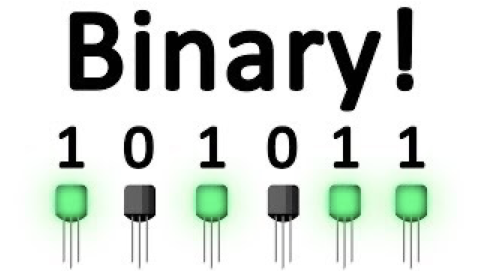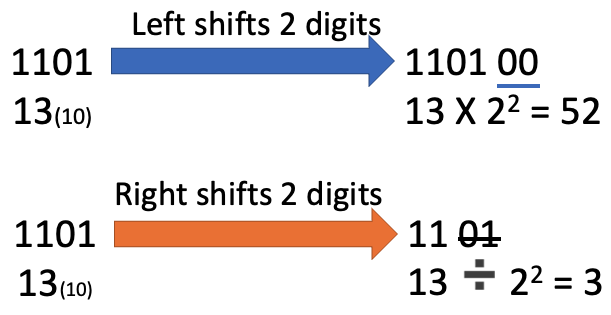Number systems


Understand binary
- Any form of data needs to be converted to binary to be processed by a computer.
- The basic building block in all computers is the binary number system.
Switch
Switch ON is 1 and OFF is 0. 

Digit weight
- Every one of us is used to the decimal or denary (base 10) number system. This uses the digits 0 to 9 which are placed in ‘weighted’ columns.
| 10000 | 1000 | 100 | 10 | 1 |
|---|---|---|---|---|
| 104 | 103 | 102 | 101 | 100 |
| 3 | 1 | 4 | 2 | 1 |
- Example: 3x10000 + 1x1000 + 4x100 + 2x10 + 1x1 = 31421
Binary to denary
- Except for denary, we use binary(base 2) and hexadecimal(base 16) number system in the computer.
| Denary value | 0 | 1 | 2 | 3 | 4 | 5 | 6 | 7 | 8 | 9 | 10 | 11 | 12 | 13 | 14 | 15 |
|---|---|---|---|---|---|---|---|---|---|---|---|---|---|---|---|---|
| Binary value | 0000 | 0001 | 0010 | 0011 | 0100 | 0101 | 0110 | 0111 | 1000 | 1001 | 1010 | 1011 | 1100 | 1101 | 1110 | 1111 |
| Hexadecimal value | 0 | 1 | 2 | 3 | 4 | 5 | 6 | 7 | 8 | 9 | A | B | C | D | E | F |
- The binary system uses 1s and 0s only which gives these corresponding weightings.
- We can convert binary number to denary according to digit weightings.
| 128 | 64 | 32 | 16 | 8 | 4 | 2 | 1 |
|---|---|---|---|---|---|---|---|
| 27 | 26 | 25 | 24 | 23 | 22 | 21 | 20 |
| 1 | 1 | 1 | 0 | 1 | 1 | 1 | 0 |
- Example: 1110 11102 = 128 + 64 + 32 + 8 + 4 + 2 = 23810
Hexadecimal to denary
- The hexadecimal system is very closely related to the binary system.
- Hexadecimal is a base 16 system.
- Because it is a system based on 16 different digits, the numbers 0 to 9 and the letters A to F are used to represent hexadecimal digits.
- A = 10, B = 11, C = 12, D = 13, E = 14 and F = 15.
- We can convert hexadecimal number to denary according to digit weightings.
| 65536 | 4096 | 256 | 16 | 1 |
|---|---|---|---|---|
| 164 | 163 | 162 | 161 | 160 |
| 0 | 1 | 1 | 2 | 3 |
Example: 0112316 = 1x4096 + 1x256 + 2x16 + 3x1 = 438710
Use of the hexadecimal system
Areas within computer science that hexadecimal is used should be identified:
- Error codes
- MAC addresses
- IPv6 addresses
- HTML colour codes
Hexadecimal is easier for humans to understand than binary, as it is a shorter representation of the binary.
When the memory contents are output to a printer or monitor, this is known as a memory dump.

Denary to binary
- Converting from denary to binary is slightly more complex.
- This method involves successive division by 2 until the result is 0; the remainders are then written from bottom to top to give the binary value.
| Divider | Result | Remainder | Process |
|---|---|---|---|
| 2 | 107 | ||
| 2 | 53 | 1 | 107 ➗ 2 = 53 ……1 |
| 2 | 26 | 1 | 53 ➗ 2 = 26 ……1 |
| 2 | 13 | 0 | 26 ➗ 2 = 13 ……0 |
| 2 | 6 | 1 | 13 ➗ 2 = 6 ……1 |
| 2 | 3 | 0 | 6 ➗ 2 = 3 ……0 |
| 2 | 1 | 1 | 3 ➗ 2 = 1 ……1 |
| 0 | 1 | 1 ➗ 2 = 0 ……1 |
- Example: 10710 = 110 10112
Denary to hexadecimal
- Converting from denary to hexadecimal is slightly similar with denary to binary.
- This method involves successive division by 16; the remainders are then written from bottom to top to give the hexadecimal value.
| Divider | Result | Remainder | Process |
|---|---|---|---|
| 16 | 2004 | ||
| 16 | 125 | 4 | 2004 ➗ 16 = 125 ……4 |
| 16 | 7 | 13(D) | 125 ➗ 16 = 7 ……13(D) |
| 16 | 0 | 7 | 7 ➗ 16 = 0 ……7 |
- Example: 200410 = 7D416
Binary to hexadecimal
- Since 16 = 24, four binary digits are equivalent to each hexadecimal digit.
| Binary value | 0000 | 0001 | 0010 | 0011 | 0100 | 0101 | 0110 | 0111 | 1000 | 1001 | 1010 | 1011 | 1100 | 1101 | 1110 | 1111 |
|---|---|---|---|---|---|---|---|---|---|---|---|---|---|---|---|---|
| Hexadecimal value | 0 | 1 | 2 | 3 | 4 | 5 | 6 | 7 | 8 | 9 | A | B | C | D | E | F |
| Denary value | 0 | 1 | 2 | 3 | 4 | 5 | 6 | 7 | 8 | 9 | 10 | 11 | 12 | 13 | 14 | 15 |
- Example: 11111000012 = 0011 1110 00012 = 3E116
Hexadecimal to binary
Since 16 = 24, one hexadecimal digit are equivalent to four binary digits.
Example: 45A16 = 0100 0101 10102
Binary addition
bianry addtion
- 0 + 0 = 0
- 1 + 0 = 1 (sum 1 and carry 0)
- 1 + 1 = 10 (sum 0 and carry 1 )
- 1 + 1 + (carry 1) = 11= sum 1 and carry 1
- Add 0 0 1 0 0 1 0 1 (37 in denary) and 0 0 1 1 1 0 1 0 (58 in denary).
| -128 | 64 | 32 | 16 | 8 | 4 | 2 | 1 | |
|---|---|---|---|---|---|---|---|---|
| 37 | 0 | 0 | 1 | 0 | 0 | 1 | 0 | 1 |
| + | ||||||||
| 58 | 0 | 0 | 1 | 1 | 1 | 0 | 1 | 0 |
| = | ||||||||
| Carry | 0 | 1 | 0 | 0 | 0 | 0 | 0 | 0 |
| Sum | 0 | 1 | 0 | 1 | 1 | 1 | 1 | 1 |
- The sum is 0101 1111, which is 95 in denary.
Overflow error
- Add 0 1 0 1 0 0 1 0 (82 in denary) and 0 1 0 0 0 1 0 1 (69 in denary).
| -128 | 64 | 32 | 16 | 8 | 4 | 2 | 1 | |
|---|---|---|---|---|---|---|---|---|
| 82 | 0 | 1 | 0 | 1 | 0 | 0 | 1 | 0 |
| + | ||||||||
| 69 | 0 | 1 | 0 | 0 | 0 | 1 | 0 | 1 |
| = | ||||||||
| Carry | 1 | 0 | 0 | 0 | 0 | 0 | 0 | 0 |
| Sum | 1 | 0 | 0 | 1 | 0 | 1 | 1 | 1 |
- The sum is 1001 0111, which is -105 (Incorrect)
Overflow error
- The expected answer for 82 + 69 is 151, which is out of range for the 8 bits register (-128~127), this is known as an overflow error.
Logical shifts
- The positive binary integer is multiplied or divided according to the shift performed.
- Bits shifted from the end of the register are lost and zeros are shifted in at the opposite end of the register.
- The most significant bit(s) or least significant bit(s) are lost.
